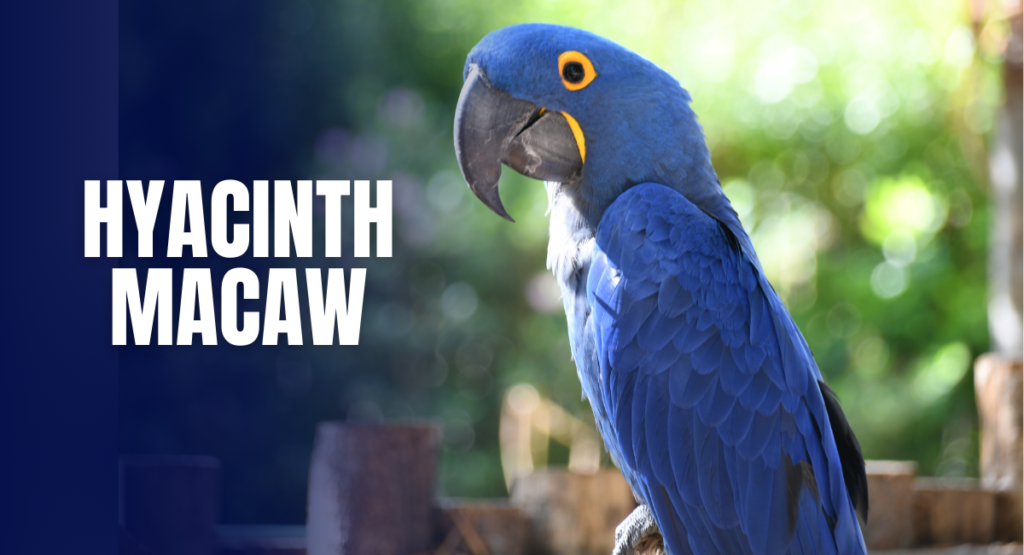The Hyacinth Macaw (Anodorhynchus hyacinthinus), often referred to as the “gentle giant” of the parrot world, is renowned for its striking cobalt-blue feathers and impressive size. As the largest flying parrot species in the world, this majestic bird captivates both bird enthusiasts and conservationists alike. Native to the lush habitats of South America, particularly the Pantanal and Amazon Basin, the Hyacinth Macaw symbolizes the vibrant biodiversity found in these regions.
Beyond its beauty, the Hyacinth Macaw plays a crucial role in its ecosystem, contributing to seed dispersal and forest health. However, despite its captivating presence, this species faces significant threats from habitat destruction and illegal pet trade. Conservation efforts are now more important than ever to ensure that future generations can continue to marvel at this extraordinary bird in the wild.
Hyacinth Macaw: The Majestic Blue Gem of the Rainforest
The Hyacinth Macaw is a stunningly beautiful bird, often called the “Blue Gem” of the rainforest. With its vibrant cobalt-blue feathers and striking yellow eye-rings, this magnificent parrot captivates anyone who sees it. Native to the forests of South America, particularly in Brazil, Bolivia, and Paraguay, the Hyacinth Macaw thrives in the dense canopy, where it feasts on a diet of nuts, seeds, and fruits. Standing as the largest flying parrot in the world, its wingspan can reach up to four feet, making it a symbol of grace and power in the avian world.
Despite its enchanting appearance, the Hyacinth Macaw faces numerous threats in the wild. Habitat destruction and illegal trapping for the pet trade have led to a significant decline in their population. Conservation efforts are underway to protect their natural habitats and prevent their exploitation. Through dedicated protection initiatives, such as breeding programs and habitat restoration, there is hope to see this majestic species flourish once again in its natural environment, ensuring that the rainforest continues to echo with the calls of this extraordinary bird.
Physical Characteristics of Hyacinth Macaw
The Hyacinth Macaw is an extraordinary bird, renowned for its impressive size and stunning blue plumage. As the largest flying parrot, it measures approximately 100 cm (39 inches) in length, including its elongated tail feathers. Its wingspan can reach an impressive 150 cm (59 inches), and it typically weighs between 1.2 to 1.7 kg (2.6 to 3.7 pounds). This majestic bird’s vibrant cobalt blue feathers are complemented by lighter blue hues on the wings and tail. Adding to its striking appearance are the vivid yellow patches around its eyes and at the base of its robust black beak.
The Hyacinth Macaw‘s powerful beak is a remarkable adaptation, capable of cracking the hardest nuts and seeds, which are staples of its diet. This beak also serves as a formidable means of defense. While this macaw is celebrated for its size and beauty, it’s interesting to note that the fastest bird in the world, the Peregrine Falcon, contrasts in size but shares a similar fascination in the avian world. Both birds, in their own unique ways, capture the awe and admiration of bird enthusiasts and naturalists alike.
Habitat and Distribution of the Hyacinth Macaw
The Hyacinth Macaw, known for its striking cobalt-blue feathers and impressive size, is native to the tropical regions of South America. Its primary habitats include the Pantanal, Amazon Basin, and Cerrado. The Pantanal, the world’s largest tropical wetland, spanning Brazil, Bolivia, and Paraguay, serves as a crucial refuge. This wetland is rich in biodiversity, providing ample food sources and nesting sites for the Hyacinth Macaw. In the Amazon Basin, the dense rainforests offer a lush environment, with towering trees that support the macaw’s need for nesting and feeding. The Cerrado, a vast Brazilian savanna-like biome, also plays a significant role in their distribution, offering a diverse landscape that supports their survival.
Interestingly, while the Hyacinth Macaw is known for its beauty and intelligence, it’s not the fastest bird in the world. Despite its large wingspan, it relies more on endurance than speed to traverse its expansive habitat. These environments are critical to the macaw’s existence, offering protection and the resources necessary for their continued survival. Conservation efforts are essential in these areas to ensure that the Hyacinth Macaw remains a vibrant part of South America’s avian diversity.

